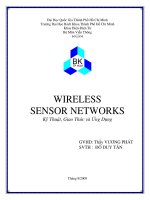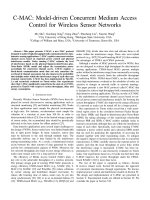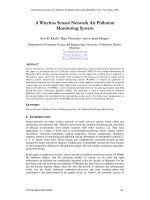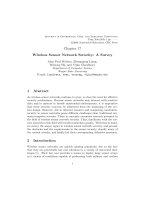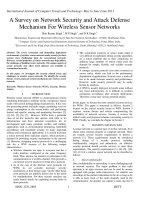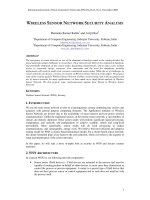Wireless sensor network
Bạn đang xem bản rút gọn của tài liệu. Xem và tải ngay bản đầy đủ của tài liệu tại đây (647.88 KB, 20 trang )
Wireless Sensor
Networks
Lớp ĐT1_K48
Nhóm thực hiện:Nguyễn Đức Tồn
Phạm Phú Tuấn
Nguyễn Anh Tuấn
Nguyễn Ngọc Đức
Đào Quang Trung
Phạm Quốc Vượng
Giáo viên hướng dẫn:
MỤC LỤC
1. INTRODUCTION
2. COMMUNICATION NETWORKS
3. WIRELESS SENSOR NETWORKS
4. Example
INTRODUCTION
• Smart environments represent the next
evolutionary development step in
building, utilities, industrial, home,
shipboard, and transportation systems
automation Like any sentient organism,
the smart environment relies first and
foremost on sensory data from the real
or1d Sensory data comes from multiple
sensors of different modalities in
distributed locations
INTRODUCTION
2.COMMUNICATION
NETWORKS
2.1
2.2
2.3
2.4
Network Topology
Communication Protocols and Routing
Power Management
Network Structure and Hierarchical Networks
2.1 Network Topology
Mesh networks
• Mesh networks:are regularly distributed
networks that generally allow transmission
only to a node’s nearest neighbors. The
nodes in these networks are generally
identical, so that mesh nets are also
referred to as peer-to-peer nets.
• Mesh nets can be good models for largescale networks of wireless sensors that are
distributed over a geographic region.
2.2 Communication Protocols
and Routing
2.2 Communication Protocols and
Routing
*Multiple Access Protocols:
In: -ALOHA
-TDMA
-FDMA
-CDMA
*Open Systems
Interconnection
Reference Model
(OSI/RM).
2.3 Power Management
2.4 Network Structure and
Hierarchical Networks
• Multicast Systems
2.4 Network Structure and
Hierarchical Networks
• Hierarchical Networks.
2.4 Network Structure and
Hierarchical Networks
• Hierarchical Networks.
2.4 Network Structure and
Hierarchical Networks
• Hierarchical Networks.
WIRELESS SENSOR NETWORKS
3.1 IEEE 1451 and Smart Sensors
3.2 Transducers and Physical
Transduction Principles
3.3 Sensors for Smart
Environments
3.4 Commercially Available
Wireless Sensor Systems
3.1 IEEE 1451 and Smart
Sensors
3.1 IEEE 1451 and Smart
Sensors
3.2 Transducers and
Physical Transduction
Principles
• Mechanical Sensors
- The Piezoresistive Effect
-Tunneling Sensing
-Capacitive Sensors
• Magnetic and Electromagnetic Sensors
-Thermal Sensors
-Acoustic Wave Sensors
•
3.3 Commercially Available
Wireless Sensor Systems
• Crossbow Berkeley Motes may be
the most versatile wireless sensor
network devices on the market for
prototyping purposes. Crossbow
( makes
three Mote processor radio module
families– MICA [MPR300] (first
generation), MICA2 [MPR400] and
MICA2-DOT [MPR500] (second
generation). Nodes come with five
sensors installed- Temperature, Light,
Acoustic (Microphone), Acceleration/
Seismic, and Magnetic. These are
especially suitable for surveillance
networks for personnel and vehicles.
4.Example: Building and Home
Automation
